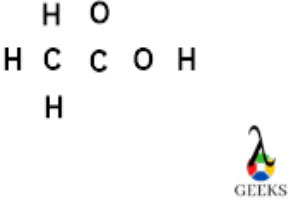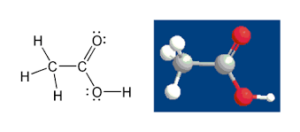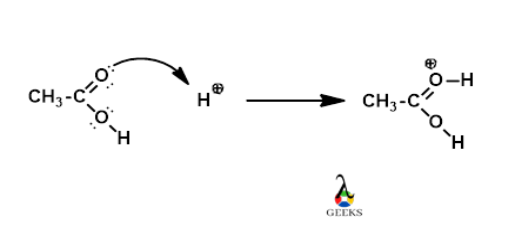In this article we will get to know about acetic acid lewis structure.
Acetic acid has the chemical formula CH3COOH and is a simple organic or monocarboxylic acid made composed of two carbons, two oxygen’s, and four hydrogens. It’s a weak acid, also known as ethanoic acid that comes out as a white liquid with a strong vinegar stench. It corrodes both metals and tissues.
How to construct the Lewis dot structure of CH3COOH in stages (Acetic acid):
Long-term acetic acid exposure can cause serious irritation in the eyes, skin, nose, throat, and other body parts, among other things. When acetic acid reaches 40 degrees Celsius, it becomes flammable and explosive. In its liquid state, acetic acid is a polar or protic solvent.
The Lewis structure or electron dot structure of acetic acid (CH3COOH) will be discussed in this article.
In the CH3COOH Lewis structure, the functional group (COOH) contains one double bond, four lone pairs on surrounding atoms, and eight bound pairs that connect one atom to another.
1. Determine the total number of valence electrons in CH3COOH
Lewis structure, also known as electron dot structure, aids in understanding how atoms or valence electrons are grouped in a molecule. As a result, the first step in constructing a Lewis diagram for every molecule is to figure out how many valence electrons are present.
Valence electrons are electrons that are found in the atom’s outermost shell. Simply look at the periodic group of atoms in the CH3COOH molecule to determine the valence electron.

Because carbon is in the 14th periodic group, oxygen is in the 16th, and hydrogen is in the first group of the periodic table, As a result, the valence electron for carbon is 4, the valence electron for oxygen is 6, and the valence electron for hydrogen is 1.
- In carbon, the total number of valence electrons is 4.
- In oxygen, the total number of valence electrons is 6.
- In hydrogen, the total number of valence electrons is one.
Total number of valence electrons accessible for the Lewis structure of CH3COOH = 4(2) + 6(2) + 1(4) = 24 valence electrons [the CH3COOH molecule comprises two carbon atoms, two oxygen atoms, and four hydrogen atoms].
2. Locate the atom with the least electronegative charge and place it in the middle
Because less electronegative atoms are more likely to exchange electrons with neighbouring atoms, the least electronegative atom always occupies the middle position in Lewis’ diagram.
The CH3COOH molecule contains three different types of atoms: hydrogen, oxygen and carbon. It’s worth noting that in the Lewis diagram, hydrogen atoms always travel outside, implying that they always take up the surrounding location, regardless of the scenario.
This is due to the fact that at their outermost shells, hydrogen can only retain two valence electrons.
Because the carbon atom has a lower electronegative charge than the oxygen atom, it occupies the middle position in the Lewis diagram.

The carboxylic group is a functional group found in the CH3COOH molecule (COOH). This group is constantly operating in a structured manner.As a result, the COOH group atoms are arranged together in the aforementioned structure, whereas hydrogen is always positioned outside in the Lewis diagram.
3. Use a single bond to connect the outside atoms to the core atom
A single connection connects all surrounding atoms to the core atom. Simply use a single bond to connect all of the exterior atoms (hydrogen and oxygen) to the centre atom (carbon).Simply begin counting the valence electrons we utilised in the structure above. Two valence electrons make form a single bond. Seven single bonds are employed to connect the surrounding atoms to the centre point in the aforementioned structure.

From a total of 24 valence electrons available for CH3COOH, 7×2 = 14 valence electrons are utilised in the above structure.
(10 valence electrons) = (24 – 14), As a result, we have an extra ten valence electrons.
4. Starting with the outer atom, place the remaining valence electrons
We’ll employ the leftover valence electron to complete the octet of outside atoms at this point (hydrogen and oxygen). “An octet is defined as an atom with eight valence electrons in its outermost shell”. Only electron pairs may be identified in the outermost shell of the hydrogen atom, making it exception to the octet rule.

Although all hydrogen atoms already have two electrons in their valence shell caused by a single link, we put all 10 leftover valence electrons on the oxygen outer atom to complete their octet, as seen in the diagram above. Because each oxygen atom has 8 valence electrons and each hydrogen atom has 2, these atoms easily completed their octet.
Can You Explain the Lewis structure for Formic Acid as Well?
Can you help with drawing formic acid lewis structure? The Lewis structure of Formic Acid consists of one carbon atom bonded to two oxygen atoms and one hydrogen atom. The carbon atom is also bonded to a hydrogen atom. The hydrogen atom is attached to one of the oxygen atoms. This structure helps us understand the arrangement of atoms and their bonding in Formic Acid.
5. Complete the core atom octet and, if required, form a covalent link
In the preceding structure, we have already finished the octet of the outer atom; now we must complete the octet of the inner atom (carbon). To achieve the octet, carbon requires 8 electrons in its outermost shell.
When looking at the fourth step structure, you can see that the left side carbon has already completed its octet because it is linked to four single bonds that share eight electrons. However, on the right side of the carbon atom, there are only three single bonds with a total of six electrons.
As a result, two more electrons are required to meet the demand for right-side carbon. However, we don’t have any spare valence electrons because we spent them all in the fourth stage construction.
In these instances, the lone pair will be converted to a covalent bond without breaking any atom’s octet.

We transform the one lone pair of oxygen electrons to a covalent link without violating any octet rule, as seen in the above structure. Looking at the above structure, we can see that our right side carbon finished the octet with ease, and that the oxygen atom, which we converted into a covalent bond with one lone pair, likewise completed the octet.

As a result, all of the atoms in the aforementioned structure have an octet, and we have our Lewis structure of CH3COOH.
6. Protonated acetic acid Lewis structure:
In protonated acetic acid, the lone pair of electrons present on the oxygen atom formed the bond with a proton.

Also Read:
- So lewis structure
- Nh4no3 lewis structure
- Nh2oh lewis structure
- Hco2 lewis structure
- Po4 3 lewis structure
- Ibr3 lewis structure
- Hclo4 lewis structure
- K2s lewis structure
- Brcl4 lewis structure
- Sbh3 lewis structure
Hi….I am D N Madhusudan, I have completed my master’s in General Chemistry from the University of Mysore. Apart from this, I like to read and listen to Music.
Let’s connect through LinkedIn: